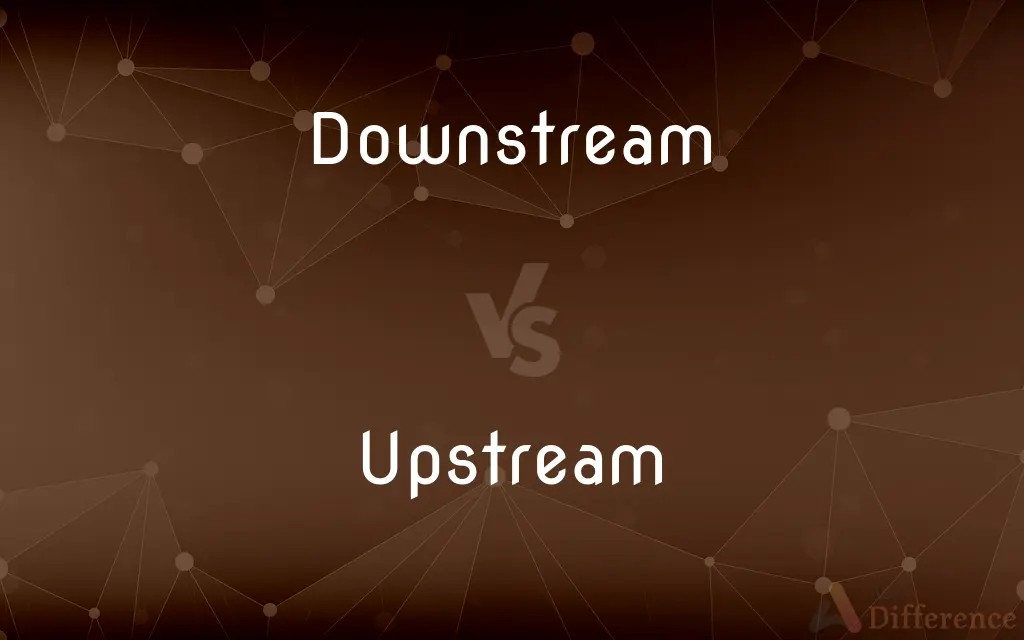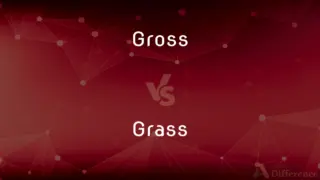Downstream vs. Upstream — What's the Difference?
By Fiza Rafique & Maham Liaqat — Updated on March 17, 2024
Downstream focuses on the distribution and retail of products, whereas upstream is concerned with the exploration and production of raw materials.

Difference Between Downstream and Upstream
Table of Contents
ADVERTISEMENT
Key Differences
Downstream in the industrial process involves refining and processing raw materials, as well as marketing and selling final products. This segment is closer to end consumers and often deals with the tangible products they use. Upstream, on the other hand, is focused on the initial stages of production, which include the exploration and extraction of natural resources. This segment is characterized by activities such as geological surveys, drilling for oil or gas, and the operation of wells.
Downstream sectors tend to be less affected by market volatility compared to upstream sectors. This is because the demand for finished products is generally more stable than the market for raw materials, which can be influenced by a wide range of geopolitical and economic factors. On the other hand, upstream sectors are highly sensitive to changes in commodity prices and regulatory environments, making them more susceptible to economic cycles and political instability.
The investment and operational focus in downstream operations are on refining, marketing, and distribution networks, which require significant infrastructure and customer service capabilities. Conversely, upstream investments are centered on exploration technologies, drilling equipment, and extraction techniques. The nature of these investments reflects the different challenges and objectives of each segment, with upstream focusing on accessing and securing raw materials and downstream on delivering finished products to consumers.
Downstream operations typically involve a broader range of activities beyond production, including customer service, logistics, and retail management. This diversity requires a multifaceted approach to business operations, incorporating elements of marketing, sales, and supply chain management. Upstream activities, while complex in their technical requirements, are more singularly focused on the efficient and effective extraction of natural resources.
In the context of sustainability and environmental impact, downstream processes often face significant scrutiny regarding their energy consumption, emissions, and waste management practices. Upstream operations, while also subject to environmental regulations, primarily contend with the challenges of minimizing ecological disruption and managing the impact of exploration and extraction activities on natural habitats.
ADVERTISEMENT
Comparison Chart
Focus
Refining, processing, marketing, and selling
Exploration and extraction of raw materials
Proximity to Consumer
Closer to end consumers
Further from consumers, closer to raw materials
Market Volatility
Less affected by market volatility
Highly sensitive to commodity prices and regulations
Investment Focus
Infrastructure for refining, marketing, distribution
Exploration technologies, drilling equipment
Environmental Impact
Energy consumption, emissions, waste management
Ecological disruption, impact on natural habitats
Compare with Definitions
Downstream
Pertaining to the latter stages of production and distribution processes.
The company's downstream operations include refining oil and selling gasoline.
Upstream
Related to the initial stages in a process, especially in production and supply chains.
The company is investing more in its upstream activities to secure raw material supplies.
Downstream
In genetics, referring to sequences that are toward the 3' end of a DNA molecule from a specific point.
The regulatory elements were identified in the downstream region of the gene.
Upstream
In genetics, referring to sequences that lie toward the 5' end of a DNA molecule from a specific point.
The promoter region is located upstream of the gene of interest.
Downstream
In computing, related to the direction of data transmission from a server to a client.
The software update was quickly distributed through downstream channels.
Upstream
Situated in or pertaining to the part of a stream or river near its source.
The expedition team set up camp upstream to ensure clean water supply.
Downstream
Relating to or situated in the part of a stream or river closer to its mouth.
The factory was located downstream to utilize water flow for cooling.
Upstream
In computing, related to the direction of data transmission from a client to a server.
Upstream bandwidth is crucial for efficient cloud backups.
Downstream
In business, involving the steps that bring products closer to the end-user.
Downstream marketing strategies focused on consumer engagement.
Upstream
In business, involving the exploration and extraction of natural resources.
The firm's profits from upstream oil operations significantly contribute to its overall revenue.
Downstream
Toward or closer to the mouth of a stream; in the direction of the current
Floated downstream.
Upstream
Toward or closer to the source of a stream; in the direction opposite to that of the current
Paddling upstream.
Downstream
At a later point in a production process or supply chain.
Upstream
At an earlier point in a production process or supply chain.
Downstream
Being or moving closer to the mouth of a stream; in the direction of the current.
Upstream
Being or moving closer to the source of a stream; in the direction opposite to that of the current
Upstream traffic.
An upstream dam.
Downstream
Later in a production process or supply chain.
Upstream
Earlier in a production process or supply chain.
Downstream
(metaphoric) Occurring later than something else; (also, usually, especially) influenced by something else; being a consequence of something else.
Input validation is downstream of input entry in the runtime process.
Upstream
In a direction against the flow of a current or stream of fluid (typically water); upriver.
Downstream
(computer networking) In the direction from the server to the client.
Upstream
(metaphoric) Occurring earlier than something else; (also, usually, especially) being an influence on something else; causing a consequence for something else.
Input entry is upstream of input validation in the runtime process.
Downstream
(biology) Towards the 3′ end of a DNA molecule.
Upstream
(oil industry) Involving exploration and pre-production rather than refining and selling.
Downstream
Following the path of a river or stream
We spent the day paddling downstream in our canoes.
Upstream
(computer networking) In the direction from the client to the server.
Downstream
To stream downward.
Upstream
(open-source software) Maintained, owned, or associated with the original developers of the given software; in contrast to a modified version downstream.
Downstream
Down the stream; as, floating downstream.
Upstream
(biology) Towards the leading end (5′ end) of a DNA molecule.
Downstream
In the direction of a stream's current
Upstream
Against the current.
Downstream
Away from the source or with the current
Upstream
(intransitive) To stream upward.
Upstream
To have (a software library, patch, etc.) accepted by the original developers of the related software, so that they maintain and distribute it.
I'd be more than happy to upstream your patch.
Upstream
Part of the river towards the upstream direction.
Upstream
(open-source software) The original developers or maintainers of software.
Upstream
Toward the higher part of a stream; against the current.
Upstream
In the direction against a stream's current
Upstream
Toward the source or against the current
Upstream
Against the current;
He swam upstream
Common Curiosities
How does market volatility affect downstream and upstream sectors?
Downstream is less affected due to stable product demand, whereas upstream is highly sensitive to commodity prices and regulations.
What is the main difference between downstream and upstream?
Downstream involves refining and distribution of products, while upstream focuses on exploration and extraction of raw materials.
How do downstream operations impact the environment?
They are scrutinized for energy consumption, emissions, and waste management practices.
What investment focus characterizes upstream operations?
Upstream investments are centered on exploration technologies and extraction equipment.
How do sustainability concerns affect upstream activities?
Upstream faces challenges in minimizing ecological disruption and managing the impact on natural habitats.
What are typical activities involved in downstream operations?
Refining raw materials, marketing, and selling final products are key downstream activities.
Why is downstream considered closer to the consumer?
It deals with refining and selling products directly used by consumers.
How does the energy sector exemplify the upstream and downstream divide?
In energy, upstream involves oil and gas exploration, while downstream includes refining and selling fuel.
What strategies are used in downstream marketing?
Downstream marketing focuses on consumer engagement and product distribution channels.
Can a company be involved in both upstream and downstream operations?
Yes, many companies in sectors like oil and gas operate across both upstream and downstream segments.
What role does logistics play in downstream operations?
Logistics is crucial for the efficient distribution and retailing of finished products in downstream operations.
How do upstream and downstream activities connect within a company?
In integrated companies, upstream provides the raw materials that are processed and sold by downstream operations.
How does the regulatory environment impact upstream activities?
Upstream is significantly influenced by regulations related to exploration and extraction practices.
What is the importance of water location in the context of upstream and downstream?
The terms also refer to positions along a river, with upstream near the source and downstream closer to the mouth.
Are upstream operations more technologically intensive?
Yes, upstream operations require advanced technologies for exploration and extraction.
Share Your Discovery

Previous Comparison
Horsefly vs. Cleg
Next Comparison
Gross vs. GrassAuthor Spotlight
Written by
Fiza RafiqueFiza Rafique is a skilled content writer at AskDifference.com, where she meticulously refines and enhances written pieces. Drawing from her vast editorial expertise, Fiza ensures clarity, accuracy, and precision in every article. Passionate about language, she continually seeks to elevate the quality of content for readers worldwide.
Co-written by
Maham Liaqat














































